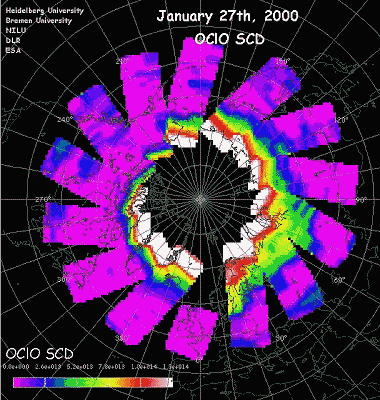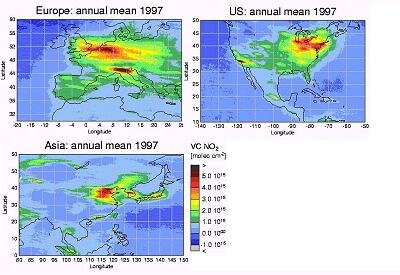New European capabilities for monitoring the ozone hole presented in Gothenburg, 16-20 October
ESA press release no. 59
The ozone layer, protecting our planet from potentially harmful ultraviolet sunlight, is threatened by human activities, in particular by the steady release of chlorofluorocarbons (CFCs) into the atmosphere. In 1987 the leading industrial countries signed the Montreal Protocol in which they agreed to phase out the products responsible for ozone depletion.
In April 1995, with the start of operations of the GOME instrument, an optical sensor on board the ERS-2 satellite, the European Space Agency opened a new chapter in ozone monitoring. Compared to the previous generation of ozone monitoring instruments, GOME offers higher spectral resolution and coverage of a broader wavelength range. This enables GOME to measure several other trace gases beside ozone.
Despite the Montreal Protocol, monitoring during the year 2000 shows that ozone is still globally declining. A 50% ozone loss over the Arctic in the lower stratosphere was observed during short periods in the spring and a record increase in the extent of the ozone hole over the Antarctic has occurred during the last month.

The CFC content of the atmosphere will remain a matter of concern for humanity for the next 50 years, the time estimated it is to take for these chemicals to disappear from the upper reaches of the atmosphere. The chemistry of the stratosphere is very complex. The ultraviolet radiation breaks up many of the species present into reactive fragments, which leads to a multitude of possible reactions.
In the past the measurement of stratospheric trace gases was the primary objective of satellite observations. Nowadays it is possible to retrieve the tropospheric content of several trace gases (e.g. nitrogen dioxide, sulphur dioxide) from GOME measurements on a global scale. This major technical development will create new opportunities for scientific research and is a further step towards the use of space for monitoring compliance with international treaties such as the Kyoto Protocol.

The new findings mentioned above have been achieved by scientific institutions working together with ESA. The latest scientific results and possible future applications based on GOME measurements will be presented at the ERS/Envisat Symposium in Gothenburg from 16 to 20 October. The Symposium will include about 600 papers by worldwide experts covering scientific results and applications of ESA’s ERS missions. It will also present the Envisat mission, to be launched in June 2001, which will contribute to global environmental monitoring.
ESA's new environmental satellite

These new European capabilities in atmospheric science will be further extended in the future by ESA’s environmental satellite Envisat, which will carry instruments even more powerful than the present ones. This will not only ensure data continuity for longer measurement history but will also make available new measurements for a better understanding of atmospheric physics and chemistry
Contacts
For more information, please contact:
ESA – Communication Department
Media Relations Office
Tel: +33 (0)1.53.69.71.55
Fax: +33 (0)1.53.69.76.90
Claus Zehner, ESA Earth Observation
Applications Engineer
Tel: +39 (0)6.94.18.05.44
Fax: +39 (0)6.94.18.05.52
Email: czehner@esrin.esa.it


